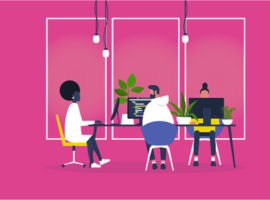2021 HR trends: The future of human resources, humanized
 The employee experience sits atop 2021 HR trends, which also include engagement, productivity, wellness, flexibility, tech, and purpose.
The employee experience sits atop 2021 HR trends, which also include engagement, productivity, wellness, flexibility, tech, and purpose.
The events of 2020 shook the field of HR to its core. Ready or not, we were propelled into our future of work plans. The theoretical was suddenly real and we had to adjust our HR priorities accordingly.
Remote work. Mental health. Racial equity. Anxiety. Reorganizations. The role of HR was thrust into the forefront of business continuity. No longer a “back office” function, best-in-class HR and people teams allowed business to survive, and in some cases thrive, despite the challenges presented by COVID-19.
 The employee experience sits atop 2021 HR trends, which also include engagement, productivity, wellness, flexibility, tech, and purpose.
The employee experience sits atop 2021 HR trends, which also include engagement, productivity, wellness, flexibility, tech, and purpose.
As we continue moving through the challenges set for us in 2020, we have a real opportunity to take control of our future like never before. Will we rise to the occasion?
I recently had an opportunity to host a fireside chat at the Spring HR Technology Conference with SAP SuccessFactors’ Global Head of Value Experience Carle Quinn and The TIMKEN Company’s Director of People Strategies Rob Arbogast to discuss the pandemic’s impact and the resulting business transformation and HR priorities.
Some of the key takeaways:
Arbogast described some of the ways the past year has impacted their complex, 140-year old $3B USD revenue global operations with 17,000 employees spanning 42 countries.
Like many industrial businesses, TIMKEN’s employee base includes a mix of employees who were able to transition to remote work and those who work on-site at plant and production facilities that are not suited for remote work. They had to be thoughtful about how and where they deployed HXM technology to ensure they understand their employees’ wants and needs through a direct line of feedback.
 Agility and adaptability are fundamental to resilience and success. Future-proof your business with an upskilling and reskilling strategy.
Agility and adaptability are fundamental to resilience and success. Future-proof your business with an upskilling and reskilling strategy.
With new agile performance, mentoring, and coaching approaches, they were committed to building employee-centric tools to support their team through these changes.
“As an engineering company that employs mechanical engineers all over the world, our staff was accustomed to focusing solely on performance outcomes,” Arbogast said.
With the introduction of HXM technology, the company shifted to a coaching and development model. HXM also enabled TIMKEN to easily adapt the different cultures of acquired companies into one common understanding of goals and performance, creating a more integrated, purpose-driven workforce, he said.
 Learn how HR tech can improve workplace diversity and inclusion when paired with a strong corporate strategy based on equality.
Learn how HR tech can improve workplace diversity and inclusion when paired with a strong corporate strategy based on equality.
TIMKEN doubled down on learning and education, both as a means to develop functional skills and as a longer-term commitment to build manager capability and strengthen their commitment to building a more inclusive workforce. They integrated their LMS with content from Harvard’s program on D&I and made that a part of their leadership curriculum that includes manager training and their 16-week “Managing for Success” course for new managers.
One of the key drivers of employee engagement is the relationship between employees and their managers. As they shifted to remote work, these relationships were often strained when many managers were managing remotely – many for the first time in their careers.
Arbogast’s team at The TIMKEN Company recognized this risk through their employee pulse survey. It led them to build a new “Engaged Leader Guide” aimed at helping their managers connect with employees under these new circumstances.
 Workplace trends driving HR include a focus on the employee experience, humanizing the workplace, and investing in HR.
Workplace trends driving HR include a focus on the employee experience, humanizing the workplace, and investing in HR.
The program includes guidance on making time to really discuss how employees are doing – including outside of work. Those kind of conversations weren’t always part of the employee-managers discussions, but now have taken on new importance as the company supports the individual circumstances each of employee faces.
As the examples above show, centering our HR technology around employee experience is key to building more human-centered business as we move through the pandemic and face whatever lies ahead. The future is ours to build. Let’s build it for and with our employees.